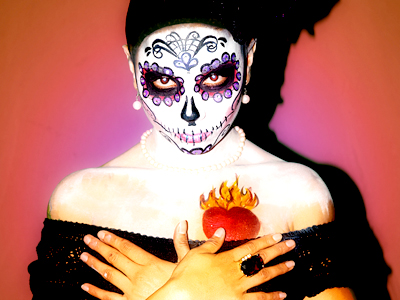
La Catrina is often associated with Dia de los muertos (day of the dead), Dia de los difuntos (day of the deceased) or Dia de los finados (day of the departed), a pre-Columbian Mesoamerican observance of death and life that is celebrated on November 2nd in all of Mexico, the Yucatan Peninsula and parts of Central America. The true story of La Catrina is one of politics and revolution.
Historically when Catholic priests or padres catolicos arrived in the new world in the 16th century in search of El Dorado, they erected their missions in order to evangelize the “heathen” natives. The church had to succumb to the idea of having to absorb these native traditions into their newly founded society. The native Mesoamerican culture had a unique perspective of life and death, viewed like heads and tails of a coin that go hand in hand - and a coin would not be a coin without the two sides. In present day, oblivious to the historical factor, many societies mix and match ancient traditions with modern day festivities. Halloween has been assimilated in the Latino community and Anglo Americans are beginning to acknowledge Day of the dead observances.
Thanks to the information age in which we live, La Catrina has increased in popularity as many portray themselves in La Catrina as part of the cultural and artistic phenomena. As part of my past media work, I placed a woman with make-up to resemble La Catrina on the front cover of Viva Mi Gente Magazine. Further efforts to revive this symbolic icon followed months later when Jose Cuervo Tequila launched a nationwide billboard campaign, along with Univision TV and many other networks.
Born as a series of witty lithographs and reliefs published in Mexico City, La Catrina was a satirical depiction of the life of the upper class during the reign of Porfirio Díaz. Her creator, Jose Guadalupe Posada (1852 – 1913), joined forces with Antonio Vanegas Arroyo, the leading publisher of popular literature in Mexico, and the two flourished. Gifted at interpreting the life and social attitudes of the Mexican people, Posada began to use Mexico’s traditional Day of the Dead celebration as his theme. He would stage scenes with skeletons in working class barrios, in suburban communities and in the houses of the elite class. Riding on bicycles and garbed in the latest finery, Posada’s skeletons became metaphors for the corrupt elitist class, and La Catrina came to life. The word catrina is the feminine form of the word catrín, which means "dandy," or one who strives to imitate an aristocratic lifestyle even though many come from middle-class backgrounds. Catrin is slang for elegant or well dressed and it refers to rich people.
In 1948 Diego Rivera, who considered Posada his artistic father, made the mural “Sueño de una tarde dominical en la Alameda” (dream of a Sunday afternoon in the Alameda park). In the famous mural, Rivera represented 400 years of Mexican history. He named the Garbancera (the beaner) La Catrina.

